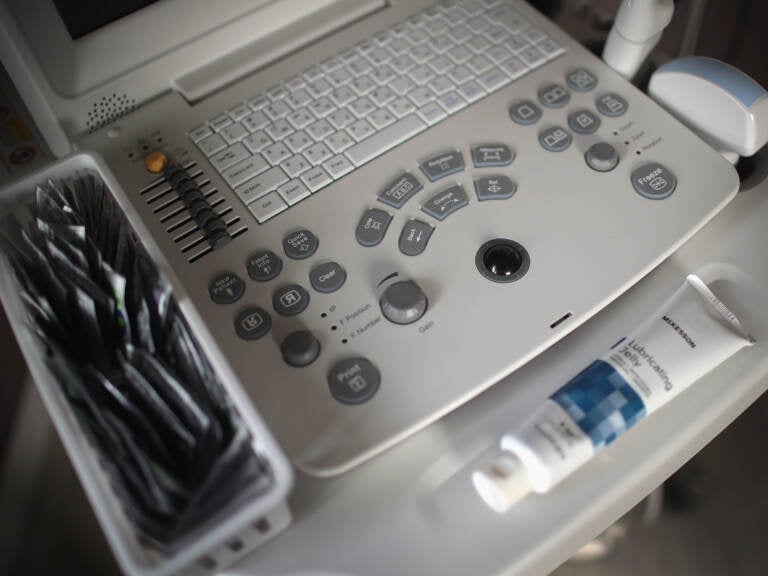The Texas abortion ban hinges on ‘fetal heartbeat.’ Doctors call that misleading

The term "fetal heartbeat," as used in the new anti-abortion law in Texas, is misleading and not based on science, say physicians who specialize in reproductive health. What the ultrasound machine detects in an embryo at six weeks of pregnancy is actually just electrical activity from cells that aren't yet a heart. And the sound that you "hear" is actually manufactured by the ultrasound machine. (Scott Olson/Getty Images)
The Texas abortion law that went into effect this week reads: “A physician may not knowingly perform or induce an abortion on a pregnant woman if the physician detected a fetal heartbeat for the unborn child.”
The new law defines “fetal heartbeat” as “cardiac activity or the steady and repetitive rhythmic contraction of the fetal heart within the gestational sac” and claims that a pregnant woman could use that signal to determine “the likelihood of her unborn child surviving to full-term birth.”
But the medical-sounding term “fetal heartbeat” is being used in this law — and others like it — in a misleading way, say physicians who specialize in reproductive health.
“When I use a stethoscope to listen to an [adult] patient’s heart, the sound that I’m hearing is caused by the opening and closing of the cardiac valves,” says Dr. Nisha Verma, an OB-GYN who specializes in abortion care and works at the American College of Obstetricians and Gynecologists.
The sound generated by an ultrasound in very early pregnancy is quite different, she says.
“At six weeks of gestation, those valves don’t exist,” she explains. “The flickering that we’re seeing on the ultrasound that early in the development of the pregnancy is actually electrical activity, and the sound that you ‘hear’ is actually manufactured by the ultrasound machine.”
That’s why “the term ‘fetal heartbeat’ is pretty misleading,” says Dr. Jennifer Kerns, an OB-GYN and associate professor at the University of California, San Francisco.
“What we’re really detecting is a grouping of cells that are initiating some electrical activity,” she explains. “In no way is this detecting a functional cardiovascular system or a functional heart.”
Kerns adds that health care providers might use the term “fetal heartbeat” in conversations with patients during this early stage of pregnancy, but it’s not actually a clinical term.
“This is a term that is not widely used in medicine,” Kern says. “I think this is an example of where we are sometimes trying to translate medical lingo in a way that patients can understand, and this is a really unfortunate side effect of this type of translation.”
Verma likens it to the term “stomach bug” — she might use that term with a patient who has gastroenteritis, she says, “but I would never use that term to talk to my colleagues or in my clinical documentation, because it’s not a precise term, it’s not a scientific term.”
In fact, “fetus” isn’t technically accurate at six weeks of gestation either, says Kerns, since “embryo” is the scientific term for that stage of development. Obstetricians don’t usually start using the term “fetus” until at least eight weeks into the pregnancy.
But “fetus” may have an appeal that the word “embryo” does not, Kern says: “The term ‘fetus’ certainly evokes images of a well-formed baby, so it’s advantageous to use that term instead of ’embryo’ — which may not be as easy for the public to feel strongly about, since embryos don’t look like a baby,” she explains. “So those terms are very purposefully used [in these laws] — and are also misleading.”
Later in a pregnancy is when a clinician might use the term “fetal heartbeat,” after the sound of the heart valves can be heard, she says. That sound “usually can’t be heard with our Doppler machines until about 10 weeks.”
The term “fetal heartbeat” has been used in laws restricting access to abortion for years. According to the Guttmacher Institute, which tracks reproductive health policy, the first such law was passed in North Dakota in 2013, but it was struck down in the courts. Since then, over a dozen states have passed similar laws, but Texas’ is the first to go into effect.
What cardiac activity means — and doesn’t mean — early in pregnancy
The text of the Texas law claims that “fetal heartbeat has become a key medical predictor that an unborn child will reach live birth” and continues, “the pregnant woman has a compelling interest in knowing the likelihood of her unborn child surviving to full-term birth based on the presence of cardiac activity.”
But obstetricians say that’s not how this information is used by health care providers. “We don’t use it to date of pregnancy,” says Dr. Samantha Kaplan, an OB-GYN at Boston Medical Center and assistant professor at Boston University’s School of Medicine.
“Or, honestly, to predict that pregnancy is going to continue until delivery.” For plenty of people, she says, this activity is detected and the pregnancy still ends in a miscarriage.
“There is nothing specific and meaningful and relevant about the detection of cardiac activity at this gestation that implies anything that’s relevant for women’s health or for pregnancies,” says Kerns. “It is one indicator — among many indicators — that a pregnancy may or may not be progressing with some expected milestones.”
Under the Texas law, women have to know they are pregnant very quickly: ‘Six weeks is just not enough time’
In reality, it would be really hard for a woman to know she’s pregnant before the point at which cardiac activity would be detectable by an ultrasound. She would have to be tracking her periods carefully, have regular periods, notice her period was late and then be able to quickly get an appointment with her doctor to confirm a pregnancy.
“Periods vary in length — and can be normal — from 21 to 42 days,” Kaplan says, adding that “late” periods can happen for many reasons, some of which have nothing to do with being pregnant. “It can be because of stress, it can be because it changes in sleep, changes in weight, travel — all of those things can do it. We actually aggressively counsel women they shouldn’t be panicked about being a week or two late.”
Pregnancies are dated from the start of a woman’s last period. A few weeks after that, if fertilization and implantation occur, Kern says, there’s “a window of a few days, maybe a week or two at the most, where you can actually detect an intrauterine pregnancy [with an ultrasound] before you detect any kind of cardiac motion or electrical activity,” says Kerns.
The Texas law is “clearly trying to move the needle back to almost to the point of detection of pregnancy with the goal of outlawing nearly all abortions,” she adds.
The way pregnancies are clinically dated is not intuitive and causes people to misunderstand the real impact of these laws, says Verma. “I actually did research around the general public’s understanding of ‘six weeks,’ ” she says. “A lot of people thought that ‘six weeks’ referred to six weeks from your first missed period, but it’s actually six weeks from your last period.”
“Six weeks is just not enough time,” she adds. “If someone has regular periods — they have a period every month at the same time — that means that once they miss a period that’s [just] two more weeks until they’re ‘six weeks pregnant.’ ”
Many people do not find out they’re pregnant that quickly. The women who are highly attuned to their cycle timing and able to get into a clinic promptly tend to be more affluent and educated, says Kaplan.
“Somebody who has easy access to health care is going to say, ‘Well, I feel a little bit nauseated. I have a little breast tenderness. I think I’ll get a pregnancy test,’ ” she says.
“Somebody who is working to get through the day and to get food on the table is not going to do that.” Getting a pregnancy test, she says, “is going to be the last thing on their list, and by the time they are doing that, it’s going to be too late.”
9(MDAzMzI1ODY3MDEyMzkzOTE3NjIxNDg3MQ001))




